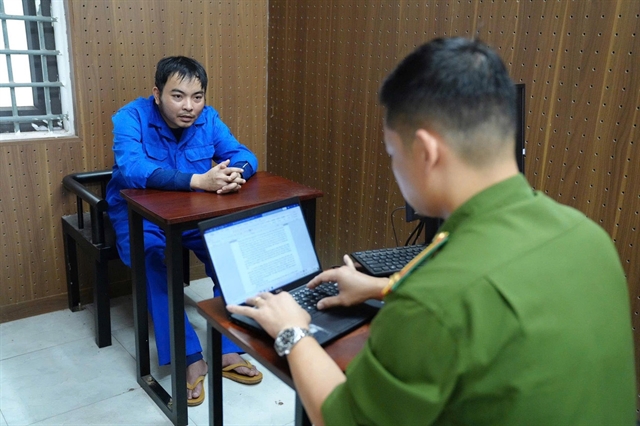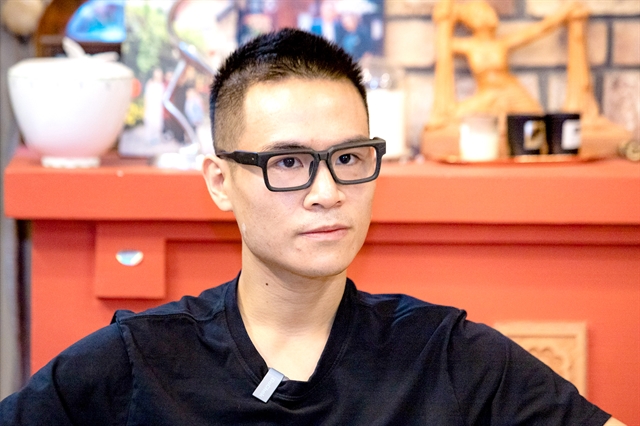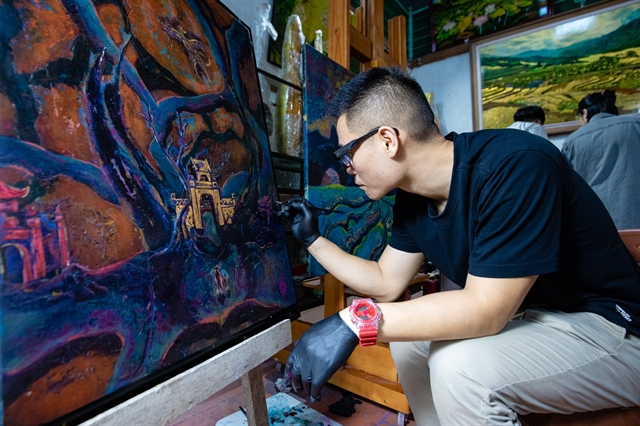 Life & Style
Life & Style


|
| Artist Chu Nhật Quang |
Artist Chu Nhật Quang will display his 50 lacquer paintings at Thăng Long Citadel in his first solo exhibition celebrating Hà Nội's 70th Liberation Day anniversary on October 10.
Việt Nam News reporter Nguyễn Bình interviews Quang about this milestone.
You are organising your first solo exhibition. Could you say something about it?
I am incredibly excited to organise my first solo exhibition, which will revolve around preserving and celebrating Vietnamese cultural values through the unique medium of sơn mài (lacquer).
The theme of this exhibition is deeply rooted in the rich heritage of Việt Nam, blending traditional elements with contemporary interpretations.
The core idea is to create a space where viewers can immerse themselves in Việt Nam’s artistic heritage while reflecting on its relevance in today’s world. Through these lacquer paintings, I aim to tell stories of Vietnamese traditions, landscapes and daily life that many might not be familiar with but which hold great significance.
The paintings will portray scenes and motifs inspired by folklore, festivals and rituals, as well as the serene beauty of rural Việt Nam.
I want the audience to feel a connection to Việt Nam’s past and contemplate how these cultural values can inspire and inform future generations.
What difficulties have you encountered in setting up your first solo exhibition?
One major advantage of this exhibition is the uniqueness of lacquer as a medium. It’s a traditional technique that is not as widely known or appreciated globally, so this exhibition will offer something new and intriguing for both local and international audiences.
Another advantage is the depth of cultural storytelling that the pieces embody, making the exhibition not only a visual experience but also an educational journey into Việt Nam’s rich heritage.
On the other hand, one challenge is that lacquer can be quite niche, and not everyone may immediately resonate with the medium. It requires viewers to spend time with each piece to appreciate the complexity and craftsmanship involved.
Also, balancing traditional elements with contemporary tastes might be a delicate task, as I aim to respect tradition while appealing to modern sensibilities.
Overall, I hope this exhibition will ignite curiosity and foster a deeper appreciation for Vietnamese culture, ensuring its values continue to thrive in a rapidly changing world.
What do you expect from this exhibition? What is the main highlight?
From my first solo exhibition, I expect to foster a deeper connection between the audience and Việt Nam’s rich cultural heritage.
I want visitors to leave with a sense of pride and understanding of the values that have been passed down through generations and how they continue to influence us today.
It’s not just about appreciating the past, but also seeing how these cultural elements - whether through ancient relics, sơn mài paintings, or water puppetry - still hold relevance and inspire present and future generations.
The highlight of the exhibition will undoubtedly be the fusion of these traditional elements, particularly the focus on ancient relics and the art of Vietnamese water puppetry.
Water puppetry is an ancient art form that tells stories of Vietnamese folklore and daily life, and incorporating it as a centerpiece allows me to bring history to life in an engaging, interactive way.
By combining visual art with performance, the exhibition aims to create a holistic journey through Việt Nam’s cultural evolution, demonstrating that these traditions are not merely historical artifacts but living practices that continue to inspire and educate future generations.
You were born into a family with a rich artistic tradition, as your grandfather and your father are also popular artists. What is the most important thing you've learned from them? And how has your family tradition influenced you?
From the moment I became aware of the world around me, the paintings of my grandfather, artist Chu Mạnh Chấn, were a precious source of inspiration, immersing me in the rustic, simple scenes of the countryside and deeply imprinting in my consciousness the essence of my homeland.
He meticulously guided me in depicting ancient architecture in my art throughout my creative journey - from when I was just a child, awkwardly sketching village gates and shrines, to the time I matured in my thinking. He then patiently helped me refine and recreate those beautiful elements, integrating them into my own paintings.
Accompanying me from the first to the 52nd painting in the exhibition series was my father, the water puppeteer Chu Lượng. He is also my mentor, inspiring me to deepen my understanding of the cultural foundations of our nation.
Through him, I was introduced to rustic puppets and the folk tales that are deeply intertwined with the customs of our civilisation. He instilled in me a love and pride for our treasured heritage. Even today, my father continues to help me shape and refine my aesthetic thinking.

|
| Chu Nhật Quang completing a lacquer painting. Photos courtesy of Chu Nhật Quang |
It seems that not many young artists are pursuing lacquer painting. What do you think?
I believe the limited number of young artists pursuing lacquer painting is largely due to the lack of resources, platforms and mentorship available for them to explore this traditional art form.
Lacquer painting is an intricate and time-consuming process that requires specific materials and techniques that aren’t as easily accessible as other mediums. Many young artists may feel discouraged because they don’t have the support or the proper introduction to the art.
However, I also see this as an opportunity to raise awareness and encourage a revival of interest in lacquer painting, which is a deeply rooted aspect of Vietnamese culture, and it has immense potential for contemporary expression.
If more platforms were available for education, training and exhibition, I believe we would see a surge in young artists embracing this medium. It’s crucial to create spaces where the tradition can evolve while staying connected to its rich heritage.
Through exhibitions like mine, I hope to inspire younger generations to explore the beauty of lacquer painting and show that it can still be relevant and exciting in the modern art world. With the right support, this traditional art form can continue to thrive.
As society develops, technology 4.0 and AI can now create vibrant paintings. Do you use AI to create art?
While I recognise the incredible advancements in technology and AI’s ability to create impressive artwork, I personally choose not to rely on AI when creating my own art.
As an artist deeply rooted in Vietnamese culture and traditions, I find endless sources of inspiration in the captivating scenery, serene environments and the rich heritage that surrounds me.
There is something profoundly unique about observing and interpreting the world through my own experiences - whether it’s the ancient relics, traditional art movements or the vibrant cultural practices that I grew up with.
For me, the process of creating art is about contemplation, observation and connection with my environment. The history, landscapes and stories of Việt Nam offer more than enough to inspire my work.
Each painting I create is a reflection of my personal journey and the cultural values I hold dear. While AI may offer convenience and speed, it cannot replace the emotional and spiritual connection I have with my subjects.
In my view, art is a deeply personal and human expression, and I take pride in using traditional methods and my own vision to translate Việt Nam’s beauty and cultural richness onto the lacquer art work.
What is your plan after your first solo exhibition?
After my first solo exhibition, I plan to continue my journey as an artist by focusing on both charitable and creative endeavors. One of my priorities is to expand my work teaching art to children with special needs.
I believe that art has the power to heal, uplift and provide a voice for those who may struggle to express themselves in traditional ways.
Through teaching, I aim to create a safe, encouraging space for these children to explore their creativity, which in turn helps foster confidence, emotional growth and a sense of community. It’s deeply meaningful work, not just for the children, but for society as a whole, as it promotes inclusion and empowerment through art. VNS



